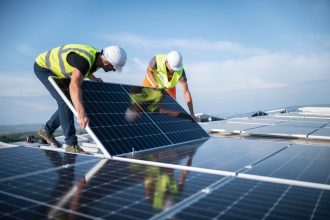“The IDR account adjustment puts everybody closer to the statutory [student loan] cancellation that they could be eligible for under the income-driven repayment plans, regardless of whether or not they enrolled in an IDR plan in the past,” explains Kyra Taylor, a staff attorney focused on student loans at the National Consumer Law Center.
Even if your loans aren’t automatically forgiven, the account adjustment will move you closer to the end of your repayment period and closer to forgiveness if you sign up for an IDR plan, which typically takes 20 or 25 years of full monthly payments.
For borrowers who’ve been in repayment for less than 20 or 25 years, here are answers to questions about the IDR account adjustment, and steps they can take to get the most out of it.
Also see: Student-loan interest is resuming. Here’s why the government charges it.
When will the IDR adjustment happen if I don’t get automatic forgiveness?
Borrowers who receive IDR credit under the account adjustment — but not enough to automatically qualify for forgiveness — will see their payment count updated sometime in 2024. The Education Department has not given an exact date yet.
How much IDR credit will I get?
To find out how much credit toward IDR forgiveness you’ll receive under the one-time IDR account adjustment, you can tally past payments yourself. Generally, borrowers get IDR forgiveness after 20 or 25 years on an IDR plan, or 240 or 300 monthly payments, which are capped at a certain percentage of their income.
Log in to your Federal Student Aid account at StudentAid.gov to see how long you’ve been in repayment. For detailed information, including descriptions of specific forbearance or deferment periods, request your account history from your servicer.
The adjustment will include the following past periods, through August 2023, toward the number of monthly payments needed to reach forgiveness:
- Any month a borrower was in repayment, even if the payments were late or partial. The type of repayment plan doesn’t matter.
- Time spent in forbearance, either periods lasting 12 or more consecutive months or a cumulative 36 or more months.
- Any month spent in deferment, other than in-school deferment, before 2013.
- Any month spent in economic hardship or military deferments on or after Jan. 1, 2013.
- Any months in repayment, forbearance or a qualifying deferment before a loan consolidation.
- Any months spent in COVID-19-related forbearance.
Past months spent in default will generally not be included in the recount, though borrowers who enroll in the temporary Fresh Start program to get out of default will get IDR credit from March 2020 through the date they leave default.
Once student loan payments resume in October, only full, on-time payments under an IDR plan will count toward the forgiveness finish line. You won’t earn IDR credit for any months you skip payments during the 12-month student loan on-ramp.
See: Biden’s student loan ‘on-ramp’ explained: Missed payments won’t hurt credit, but interest keeps adding up
How to benefit from the account adjustment
The account adjustment will be automatic for most borrowers, but some borrowers need to take an extra step before the end of 2023. If you want to benefit from the account adjustment to reach loan forgiveness more quickly, you must sign up for an IDR plan.
Consolidate your loans if necessary
Borrowers with certain types of loans will need to consolidate them into direct loans by the end of 2023 to receive the account adjustment.
These types of loans must be consolidated to receive IDR credit if they don’t reach the forgiveness threshold:
- Commercially managed FFEL Program loans, i.e., those held by companies like Navient.
- Perkins loans.
- Health Education Assistance Loan (HEAL) Program loans.
- Parent PLUS loans.
To check the types of loans you have and start the consolidation process, log in to your Federal Student Aid account and start a direct loan consolidation application.
If you consolidate loans that were in repayment for different periods of time, the new consolidation loan gets the maximum amount of IDR credit that accrued among the loans, Taylor explains.
Enroll in an IDR plan
Federal student loan borrowers will need to start making payments again this fall. Interest resumed on Sept. 1, and bills will come due in October.
For borrowers who anticipate having a leftover balance after the account adjustment, enrolling in an IDR plan now is very important, says Mike Pierce, executive director of the Student Borrower Protection Center, a nonprofit that advocates for student debt relief. This will allow borrowers to continue making progress toward IDR loan forgiveness once payments restart, he says.
Borrowers can choose from four IDR plans: Pay As You Earn (PAYE), Income-Based Repayment (IBR), Income-Contingent Repayment (ICR), and the newest IDR plan, Saving on a Valuable Education (SAVE). Use the Federal Student Aid office’s loan simulator tool to compare repayment plans and determine your best fit.
SAVE is a good option for most borrowers. Benefits include halved monthly bills for most borrowers with undergraduate loans, no compounding interest if you make regular payments and faster forgiveness for borrowers with smaller balances.
Some middle- or low-income borrowers could even see $0 monthly payments under SAVE, while working toward loan forgiveness. For these borrowers, SAVE “is basically an extension of the payment pause that you just have to fill out some paperwork for,” Pierce says.
Learn more: How to sign up for SAVE, the student-loan repayment plan Biden officials are calling a ‘game changer’
Parent PLUS borrowers are only eligible for the Income-Contingent Repayment plan, which is the “least generous” of the four IDR plans, says Taylor. Monthly ICR payments can be high: they’re capped at 20% of the borrower’s discretionary income, rather than 5% to 10% under the other three IDR plans.
Borrowers with parent PLUS loans should see how close they are to cancellation and whether it’s worth it to consolidate and enroll in ICR as a step toward loan forgiveness, Taylor explains.
Read: Parent PLUS borrowers: What to watch for as student loan payments resume, including a loophole
What if I’m enrolled in Public Service Loan Forgiveness?
Borrowers enrolled in Public Service Loan Forgiveness (PSLF) are on a slightly different account adjustment timeline.
If you have at least one approved PSLF form, you may see your payment count adjusted as early as the fall of 2023. Servicers will continue to adjust PSLF counts monthly until the final adjustment in 2024.
Under the account adjustment, you’ll get PSLF credit for any month, dating back to October 2007, in which you had qualifying employment and were in a repayment status, regardless of the payments made, loan type or repayment plan. Borrowers who qualify for PSLF get loan forgiveness after just 10 years, or 120 monthly payments.
The account adjustment is automatic for all PSLF-eligible Direct Loans, including consolidated and unconsolidated parent PLUS loans — but borrowers with commercially or federally held FFELP loans must consolidate them before the end of 2023 to receive the adjustment.
Use the Federal Student Aid office’s PSLF Help Tool to certify periods of employment and track progress toward loan forgiveness under PSLF.
More From NerdWallet
Eliza Haverstock writes for NerdWallet. Email: [email protected]. Twitter: @elizahaverstock.
Read the full article here





